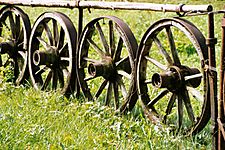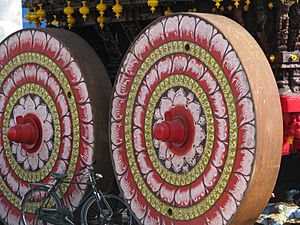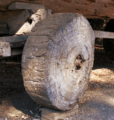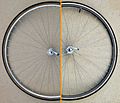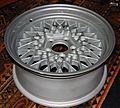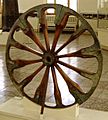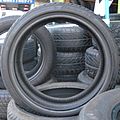Wheel facts for kids
A wheel is a disc- or circle-shaped mechanical device. Its main purpose is to allow things to roll; in other words, the wheel spins, and objects on the wheels move more easily along the ground. It is a simple machine.
History
The place and time of the invention of the wheel remains unclear, because the oldest hints do not guarantee the existence of real wheeled transport, or are dated with too much scatter. Mesopotamian civilization is credited with the invention of the wheel by several, mainly old sources. However, some recent sources either suggest that it was invented independently in both Mesopotamia and Eastern Europe or credit prehistoric Eastern Europeans with the invention of the wheel and that unlike other breakthrough inventions, the wheel cannot be attributed to a single nor several inventors. Evidence of early usage of wheeled carts has been found across the Middle East, in Europe, Eastern Europe, India and China. It is not known whether Chinese, Indians, Europeans and even Mesopotamians invented the wheel independently or not.
The invention of the solid wooden disk wheel falls into the late Neolithic, and may be seen in conjunction with other technological advances that gave rise to the early Bronze Age. This implies the passage of several wheelless millennia even after the invention of agriculture and of pottery, during the Aceramic Neolithic.
- 4500–3300 BCE (Copper Age): invention of the potter's wheel; earliest solid wooden wheels (disks with a hole for the axle); earliest wheeled vehicles; domestication of the horse
- 3300–2200 BCE (Early Bronze Age)
- 2200–1550 BCE (Middle Bronze Age): invention of the spoked wheel and the chariot

The Halaf culture of 6500–5100 BCE is sometimes credited with the earliest depiction of a wheeled vehicle, but this is doubtful as there is no evidence of Halafians using either wheeled vehicles or even pottery wheels. Precursors of pottery wheels, known as "tournettes" or "slow wheels", were known in the Middle East by the 5th millennium BCE. One of the earliest examples was discovered at Tepe Pardis, Iran, and dated to 5200–4700 BCE. These were made of stone or clay and secured to the ground with a peg in the center, but required significant effort to turn. True potter's wheels, which are freely-spinning and have a wheel and axle mechanism, were developed in Mesopotamia (Iraq) by 4200–4000 BCE. The oldest surviving example, which was found in Ur (modern day Iraq), dates to approximately 3100 BCE. Wheels of uncertain dates have also been found in the Indus Valley civilization, a 4th millennium BCE civilization covering areas of present-day India and Pakistan.
The oldest indirect evidence of wheeled movement was found in the form of miniature clay wheels north of the Black Sea before 4000 BCE. From the middle of the 4th millennium BCE onward, the evidence is condensed throughout Europe in the form of toy cars, depictions, or ruts, with the oldest find in Northern Germany dating back to around 3400 BCE. In Mesopotamia, depictions of wheeled wagons found on clay tablet pictographs at the Eanna district of Uruk, in the Sumerian civilization are dated to c. 3500–3350 BCE. In the second half of the 4th millennium BCE, evidence of wheeled vehicles appeared near-simultaneously in the Northern (Maykop culture) and South Caucasus and Eastern Europe (Cucuteni-Trypillian culture).
Depictions of a wheeled vehicle appeared between 3631 and 3380 BCE in the Bronocice clay pot excavated in a Funnelbeaker culture settlement in southern Poland. In nearby Olszanica, a 2.2 m wide door was constructed for wagon entry; this barn was 40 m long with three doors, dated to 5000 B.C.E—7000 years old, and belonged to the neolithic Linear Pottery culture. Surviving evidence of a wheel-axle combination, from Stare Gmajne near Ljubljana in Slovenia (Ljubljana Marshes Wooden Wheel), is dated within two standard deviations to 3340–3030 BCE, the axle to 3360–3045 BCE. Two types of early Neolithic European wheel and axle are known: a circumalpine type of wagon construction (the wheel and axle rotate together, as in Ljubljana Marshes Wheel), and that of the Baden culture in Hungary (axle does not rotate). They both are dated to c. 3200–3000 BCE. Some historians believe that there was a diffusion of the wheeled vehicle from the Near East to Europe around the mid-4th millennium BCE.
Early wheels were simple wooden disks with a hole for the axle. Some of the earliest wheels were made from horizontal slices of tree trunks. Because of the uneven structure of wood, a wheel made from a horizontal slice of a tree trunk will tend to be inferior to one made from rounded pieces of longitudinal boards.
The spoked wheel was invented more recently and allowed the construction of lighter and swifter vehicles. The earliest known examples of wooden spoked wheels are in the context of the Sintashta culture, dating to c. 2000 BCE (Krivoye Lake). Soon after this, horse cultures of the Caucasus region used horse-drawn spoked-wheel war chariots for the greater part of three centuries. They moved deep into the Greek peninsula where they joined with the existing Mediterranean peoples to give rise, eventually, to classical Greece after the breaking of Minoan dominance and consolidations led by pre-classical Sparta and Athens. Celtic chariots introduced an iron rim around the wheel in the 1st millennium BCE.
In China, wheel tracks dating to around 2200 BCE have been found at Pingliangtai, a site of the Longshan Culture. Similar tracks were also found at Yanshi, a city of the Erlitou culture, dating to around 1700 BCE. The earliest evidence of spoked wheels in China comes from Qinghai, in the form of two wheel hubs from a site dated between 2000 and 1500 BCE.
In Britain, a large wooden wheel, measuring about 1 m (3.3 ft) in diameter, was uncovered at the Must Farm site in East Anglia in 2016. The specimen, dating from 1,100 to 800 BCE, represents the most complete and earliest of its type found in Britain. The wheel's hub is also present. A horse's spine found nearby suggests the wheel may have been part of a horse-drawn cart. The wheel was found in a settlement built on stilts over wetland, indicating that the settlement had some sort of link to dry land.
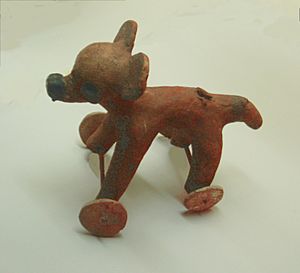
Although large-scale use of wheels did not occur in the Americas prior to European contact, numerous small wheeled artifacts, identified as children's toys, have been found in Mexican archeological sites, some dating to approximately 1500 BCE. Some argue that the primary obstacle to large-scale development of the wheel in the Americas was the absence of domesticated large animals that could be used to pull wheeled carriages. The closest relative of cattle present in Americas in pre-Columbian times, the American bison, is difficult to domesticate and was never domesticated by Native Americans; several horse species existed until about 12,000 years ago, but ultimately became extinct. The only large animal that was domesticated in the Western hemisphere, the llama, a pack animal, was not physically suited to use as a draft animal to pull wheeled vehicles, and use of the llama did not spread far beyond the Andes by the time of the arrival of Europeans.
On the other hand, Mesoamericans never developed the wheelbarrow, the potter's wheel, nor any other practical object with a wheel or wheels. Although present in a number of toys, very similar to those found throughout the world and still made for children today ("pull toys"), the wheel was never put into practical use in Mesoamerica before the 16th century. Possibly the closest the Mayas came to the utilitarian wheel is the spindle whorl, and some scholars believe that these toys were originally made with spindle whorls and spindle sticks as "wheels" and "axes".
Aboriginal Australians traditionally used circular discs rolled along the ground for target practice.
Nubians from after about 400 BCE used wheels for spinning pottery and as water wheels. It is thought that Nubian waterwheels may have been ox-driven. It is also known that Nubians used horse-drawn chariots imported from Egypt.
Starting from the 18th century in West Africa, wheeled vehicles were mostly used for ceremonial purposes in places like Dahomey. The wheel was barely used for transportation, with the exception of Ethiopia and Somalia in Sub-Saharan Africa well into the 19th century.
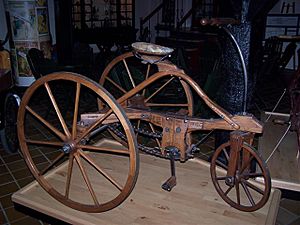
The spoked wheel was in continued use without major modification until the 1870s, when wire-spoked wheels and pneumatic tires were invented. Pneumatic tires can greatly reduce rolling resistance and improve comfort. Wire spokes are under tension, not compression, making it possible for the wheel to be both stiff and light. Early radially-spoked wire wheels gave rise to tangentially-spoked wire wheels, which were widely used on cars into the late 20th century. Cast alloy wheels are now more commonly used; forged alloy wheels are used when weight is critical.
The invention of the wheel has also been important for technology in general, important applications including the water wheel, the cogwheel (see also antikythera mechanism), the spinning wheel, and the astrolabe or torquetum. More modern descendants of the wheel include the propeller, the jet engine, the flywheel (gyroscope) and the turbine.
Modern Uses
Today, wheels are used in cars, carts, airplanes, wheelchairs, bicycles, trains, caravans and skateboards, in addition to many more devices. Wheels are usually used in pairs,connected by a rod of wood or metal known as an axle.
Related pages
Images for kids
-
Spoked wheel with bronze sheeting from Árokalja. 1000 BC.
-
Radially- (left) and tangentially- (right) wire-spoked wheels, both with pneumatic tires
-
Cast alloy wheel on a folding bicycle, with a pneumatic tire.
-
A spoked wheel on display at The National Museum of Iran, in Tehran. The wheel is dated to the late 2nd millennium BCE and was excavated at Choqa Zanbil.
See also
 In Spanish: Rueda para niños
In Spanish: Rueda para niños


